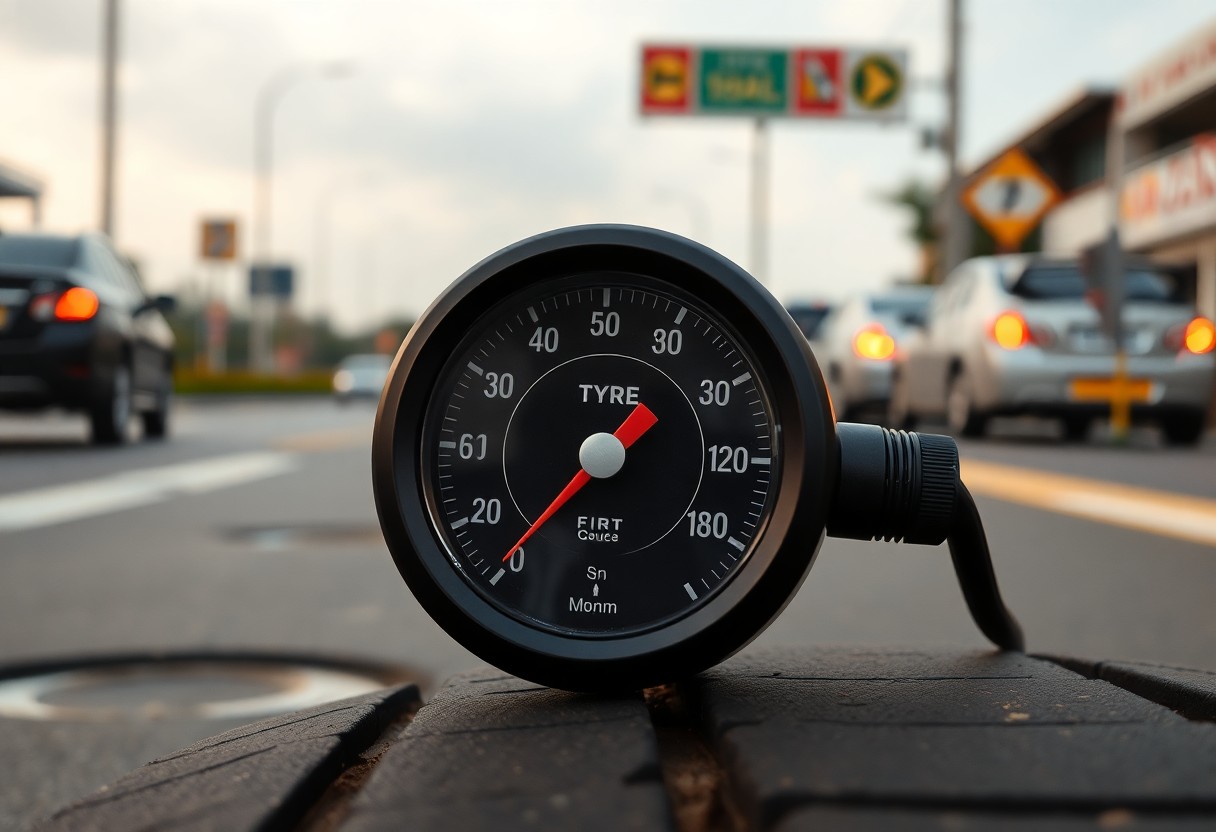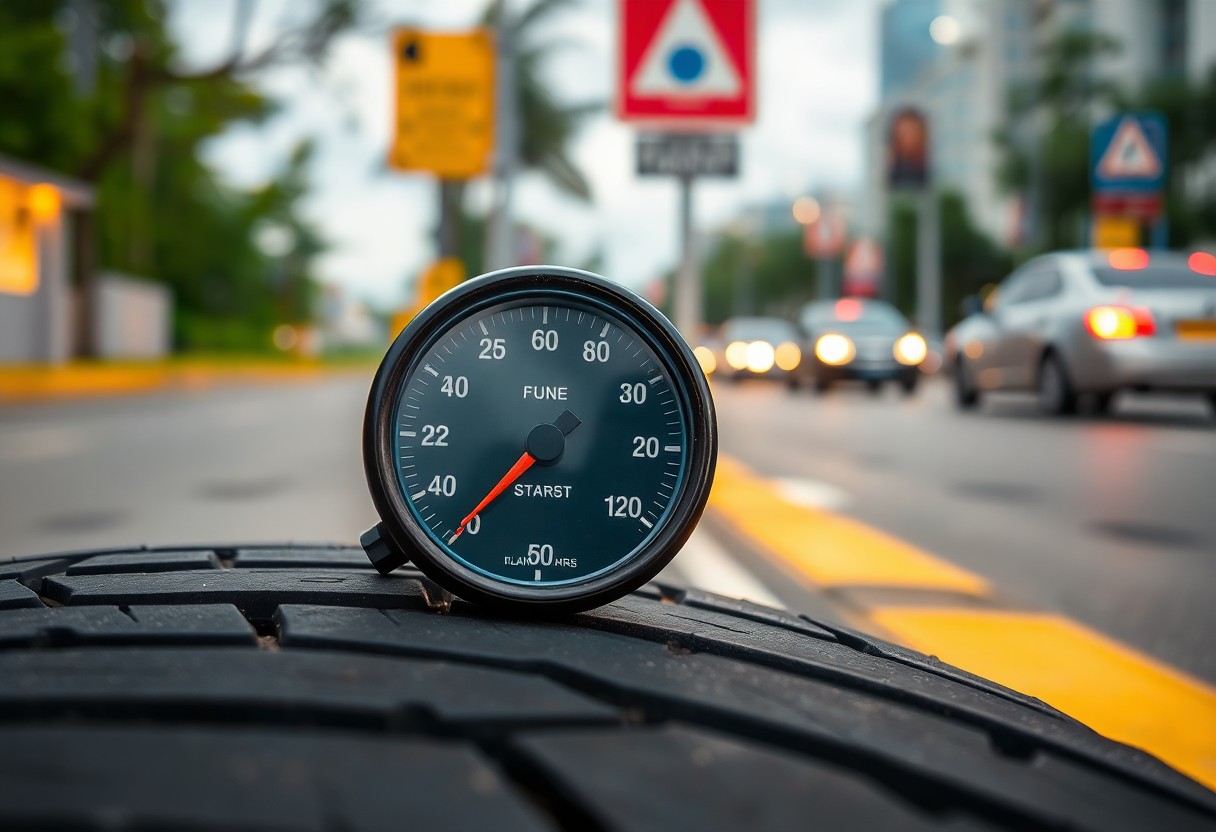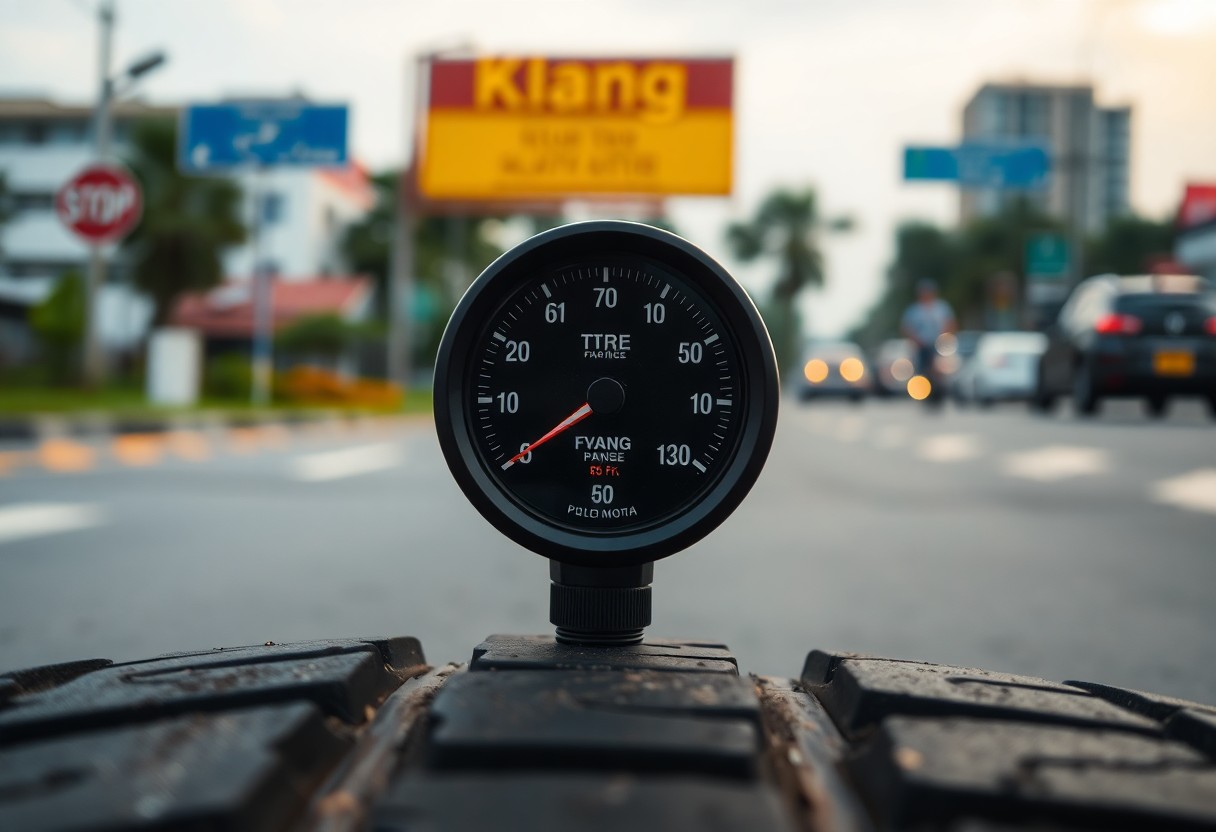You need to know that tyre pressure plays a vital role in ensuring your safety and driving comfort on Klang roads. Maintaining the correct pressure not only enhances fuel efficiency but also prevents uneven tyre wear, maximizing your vehicle’s performance. Given Klang’s diverse road conditions, including highways and urban areas, adhering to the manufacturer’s recommended pressure is crucial. In this blog post, we will explore the optimal tyre pressure for different vehicles on Klang roads, helping you make informed decisions for a smooth and safe driving experience.

Key Takeaways:
- Maintaining the right tyre pressure enhances vehicle handling and safety on Klang’s diverse road conditions.
- Regularly check tyre pressure at least once a month and before long journeys to ensure optimal performance.
- Adjust tyre pressure based on vehicle load; heavier loads may require slightly higher pressure.
- Refer to the manufacturer’s guidelines for the recommended tyre pressure for your specific vehicle model.
- Seasonal temperature changes can affect tyre pressure; always adjust accordingly to keep it within the recommended range.
- Adequate tyre pressure contributes to better fuel efficiency, leading to cost savings over time.
- Check for any signs of wear or damage on tyres, as they can influence pressure needs and overall safety.

The Terrain Truth: Understanding Klang’s Road Conditions
Klang’s road surfaces vary significantly, impacting your tyre performance. Urban areas feature well-maintained, asphalt roads, suitable for standard tyre pressure levels. In contrast, rural routes can be uneven, often presenting challenges like potholes and gravel patches that necessitate adjustments in tyre inflation for optimal grip and stability. Be aware of these conditions to ensure your car maintains performance and safety throughout your travels.
Urban vs. Rural: A Tale of Two Tyres
The difference between urban and rural driving in Klang calls for varied tyre pressure settings. In urban settings, where roads are smooth, a standard pressure of around 32 PSI works well. Conversely, rural roads may need you to decrease pressure slightly, around 28 PSI, to enhance traction and cushion against bumps.
Weather Patterns and Their Impact on Tyre Pressure
Klang experiences a tropical climate, leading to humidity and temperature fluctuations that can affect tyre pressure. Heat can cause air inside the tyres to expand, raising the pressure above recommended levels, while the cooler evenings may cause it to drop. Regular checks are advisable to adjust for these changes.
In Klang, the average temperature ranges from 25°C to 32°C, influencing your tyre pressure significantly. For every 10°C increase in temperature, tyre pressure can rise by about 1 PSI. Therefore, if you typically inflate your tyres at cooler temperatures, be prepared to check and possibly release some air when driving on hotter days to avoid the risks of over-inflation, such as blowouts and uneven wear. Regular monitoring keeps you in control and ensures safer driving conditions in various weather.
The Inflation Equation: Ideal Tyre Pressures for Klang Drivers
For Klang drivers, finding the correct tyre pressure involves balancing factors such as vehicle type and weight. A general recommendation usually falls between 30 to 35 PSI, but adhering strictly to these numbers may not be optimal. Various elements like climate, driving habits, and road conditions can necessitate adjustments to maintain traction and efficiency, ensuring safety and performance on Klang’s often unpredictable terrain.
Manufacturer Recommendations: Are They Enough?
Following manufacturer recommendations for tyre pressure is a solid starting point but may not always suffice for Klang’s diverse conditions. These guidelines typically stem from standard testing, lacking insight into unique environmental factors such as local humidity, temperature variations, and road surfaces. As a driver, it’s wise to take these specs into account while also observing your tyres’ performance in real-life scenarios.
Adjusting for Load: How Carrying Capacity Affects Pressure
Your vehicle’s load significantly influences tyre pressure requirements. When you’re carrying a heavier load, it’s necessary to increase inflation beyond the standard recommendation to distribute the weight evenly. For example, if you’re loading up for a family road trip, adjusting your tyre pressure to around 5 PSI higher than usual can help maintain optimal handling and reduce the risk of tyre blowouts.
Understanding how load affects tyre pressure not only enhances driving comfort but also promotes safety. Tyres that are under-inflated while carrying heavy cargo can lead to decreased fuel efficiency and increased wear. If you’re routinely transporting goods or passengers, constantly assess the payload and make the necessary adjustments to ensure the performance remains steady. Keeping a manual pump in your vehicle kit can help you stay proactive about making these adjustments whenever you hit the road.

Performance versus Safety: The Balancing Act of Tyre Pressure
The optimal tyre pressure directly impacts both performance and safety, forcing a delicate balance that you must maintain. Adequate pressure ensures improved fuel efficiency and handling, but it also significantly influences braking distances and the overall stability of your vehicle. Finding that sweet spot is crucial; an improper pressure level can result in compromised cornering ability, increased wear on tyres, and in more severe cases, blowouts. Striving for the recommended pressure according to your vehicle’s specifications can help mitigate the risks while enjoying enhanced performance.
Under-Inflation Risks: What’s at Stake?
Speeding down Klang’s roads on under-inflated tyres introduces hazards like decreased fuel efficiency and reduced handling capabilities. As tyres become excessively soft, their friction with the road increases, leading to more rapid wear and tear. Beyond that, driving with under-inflated tyres heightens the risk of broadcasting heat buildup, resulting in potential blowouts and compromised safety.
The Dangers of Over-Inflation: Why Less Isn’t Always More
Pushing your tyres beyond their recommended inflation can create a host of safety concerns. Over-inflated tyres can lead to decreased contact with the road, resulting in less traction and a harsher ride. As you navigate Klang’s varied terrains, the tyres may struggle with grip, especially on wet surfaces. This can make your vehicle more prone to skidding during sudden stops or sharp turns.
Furthermore, over-inflation causes uneven wear, leading to a higher likelihood of centre tread wear, ultimately shortening tyre lifespan. If left unchecked, this can also amplify the risk of a blowout at high speeds. The ideal inflation helps maintain an even contact patch, which is crucial for safe handling and optimal performance. Regularly checking your tyre pressure, especially after fluctuations in temperature or before long commutes, can safeguard against these detrimental effects.
Practical Tips for Maintaining Optimal Tyre Pressure
Maintaining optimal tyre pressure helps ensure the safety and performance of your vehicle. Regularly check your tyres using a reliable pressure gauge and adhere to your vehicle manufacturer’s recommended PSI. *Always* inspect your tyres when they are cold for the most accurate reading. Keep an eye out for signs of wear, such as uneven tread, and schedule a rotation every 5,000 to 8,000 kilometers. Agreeing with the *manufacturer’s guidelines* can significantly enhance *fuel efficiency*. Thou must prioritize checking your tyre pressure.
- Use a reliable *pressure gauge*
- Check *PSI* when tyres are cold
- Inspect for any *wear* or damage
- Rotate tyres every *5,000 to 8,000 kilometers*
Tools of the Trade: Essential Equipment for Drivers
To keep your tyres in top condition, having the right tools is vital. A quality *tyre pressure gauge* is a must-have to make accurate measurements. Consider also purchasing a portable air compressor that allows you to adjust your tyre pressure wherever needed. Don’t forget your *tyre repair kit* for minor issues on the road. These tools will empower you to proactively manage your tyres, ensuring optimal performance and safety.
Frequency Matters: How Often to Check Your Tyre Pressure
Checking your tyre pressure should be part of your regular vehicle maintenance. Aim to check your tyres at least once a month and before long trips or when carrying heavy loads. Temperature fluctuations can affect tyre pressure, so consider checking more often during extreme weather conditions. Staying on top of your tyre maintenance not only prolongs tyre life but also promotes better fuel efficiency and enhances your driving experience.
Routine checks of your tyre pressure, ideally every few weeks or before long journeys, contribute to optimal vehicle performance. Tyres lose air naturally at a rate of 1 to 2 PSI per month, exacerbated by temperature changes. Maintaining your factory-recommended pressure can save you money on fuel and reduce the risk of unexpected tyre failure, making the habit all the more worthwhile.
Real-World Implications: How Tyre Pressure Affects Your Wallet
Proper tyre pressure extends beyond safety and handling; it directly impacts your wallet. Under-inflated tyres create more resistance, causing your engine to work harder, which in turn leads to higher fuel consumption. You might be surprised to learn that maintaining optimal inflation levels can result in significant savings at the pump over time. Since fuel prices fluctuate, keeping a close eye on your tyre pressure can lead to noteworthy financial gains.
Fuel Efficiency Factors: The Financial Case for Proper Inflation
Properly inflated tyres can improve fuel efficiency, helping you avoid unnecessary spending. Here’s how:
- Better mileage: Increased inflation optimizes fuel usage.
- Lower emissions: Proper pressure helps reduce your carbon footprint.
- Increased lifespan: Well-maintained tyres need replacement less often.
Knowing that even a slight decrease in pressure can increase fuel costs by up to 3%, ensuring your tyres are inflated correctly becomes a simple yet effective way to save money.
Longevity and Maintenance: Tyre Life Beyond Just Pressure
Tyre pressure is a vital factor, but its influence on the longevity of your tyres shouldn’t be underestimated. Well-maintained tyres provide a smoother ride and better handling, leading to less wear and tear on the tread. Over time, proper inflation helps maintain even wear, allowing you to maximize your investment. Regular checks can help you avoid uneven tread life, which ultimately translates into needing to replace tyres less frequently.
Moreover, maintaining optimal tyre pressure can protect the internal components of your tyres, reducing the risk of blowouts or punctures. Research shows that tyres maintained at the correct pressure can last up to 25% longer, meaning that regular monitoring could delay your next purchase significantly. Also, tyre maintenance, such as rotations and balancing, along with keeping them properly inflated, ensures not only safety but also performance consistency, emphasizing that your vehicle’s upkeep is a direct correlation to financial savings.
To wrap up
Ultimately, the best tyre pressure for Klang roads typically falls between 30 to 35 PSI, depending on your vehicle type and load. Ensuring your tyres are properly inflated can significantly enhance your vehicle’s handling, fuel efficiency, and overall safety. Regularly checking and adjusting your tyre pressure can help you navigate Klang’s unique road conditions more effectively, providing a smoother driving experience and prolonging the life of your tyres. Always consult your vehicle’s manual for specific recommendations tailored to your car.
FAQ
Q: What is the recommended tyre pressure for vehicles in Klang?
A: The recommended tyre pressure varies depending on the type of vehicle and the manufacturer’s specifications. Generally, most passenger cars have a recommended pressure between 30 to 35 PSI. However, always check your vehicle’s owner manual or the sticker located on the driver’s side door jamb for the exact pressure needed.
Q: How does road condition in Klang affect tyre pressure?
A: Klang roads can differ significantly, with some areas having well-maintained surfaces while others may have potholes or uneven terrain. These conditions can lead to fluctuations in tyre pressure. Roads with more wear and tear may require slightly higher tyre pressure to better absorb impacts and maintain stability.
Q: Why is it important to maintain proper tyre pressure in Klang?
A: Maintaining proper tyre pressure is vital for safety, fuel efficiency, and tyre longevity. In Klang, fluctuating temperatures can also affect tyre pressure. Under-inflated tyres can lead to poor handling, increased wear, and can contribute to the likelihood of a blowout, especially on rough roads.
Q: How often should I check my tyre pressure in Klang?
A: It is advisable to check your tyre pressure at least once a month and before long trips. Additionally, checking after significant temperature changes or extended periods of heavy rain can help ensure your tyres remain at optimal pressure.
Q: What should I do if I experience uneven tyre wear on Klang roads?
A: Uneven tyre wear can indicate incorrect tyre pressure, misalignment, or suspension issues. First, check your tyre pressure to ensure it matches the recommended levels. If the issue persists, consider taking your vehicle to a qualified mechanic for a thorough inspection and alignment adjustments.
Q: Can I use the same tyre pressure for both front and rear tyres on Klang roads?
A: Typically, the front and rear tyres have different pressure recommendations due to their differing roles in handling and weight distribution. Always consult your vehicle’s owner manual or the manufacturer’s guidance to ascertain the correct pressures for both front and rear tyres.
Q: How does temperature affect tyre pressure in Klang?
A: Temperature changes can significantly affect tyre pressure. As the temperature increases, tyre pressure typically rises, while cooler temperatures can cause it to drop. Since Klang experiences warm weather, be mindful of checking tyre pressure more frequently in hot conditions to ensure it remains within the recommended levels.
